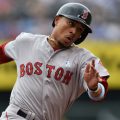It took until 1988 for the Chicago Cubs to install lights at Wrigley Field. Even then, a city ordinance was passed prohibiting the Cubs from playing more than 18 night games per season. There were several reasons for this city-wide fascination with day games, but none pertained to player performance. While the Cubs eventually increased the potential number of night games per season, the issue did not disappear.
Kerry Wood was the first prominent Cub to shed a negative light on the team’s high number of day games. Wood likened the team’s constantly changing start times to “being a shift worker in a factory.” Manager Dusty Baker pointed out that it helped to have guys who were married with families on the team, as they were less likely to stay out late at night.
In 2017, day games are a regular occurrence in MLB, especially in April, May, June, and July. Does the time of day make a difference in player performance? Let’s find out.
Hitters in Day Games vs. Night Games
For the purposes of this study, a day game is defined as any that starts prior to 7:00 pm ET. A night game is defined as any that starts at 7:00 pm ET or later. Per our Trends tool, since 2014 there’s been virtually no difference in the DraftKings performance of hitters depending on time of day:

The degree of similarity in raw production, Plus/Minus, and Consistency Rating is actually a little scary. Results from just last season are comparable: In 2016 hitter performance wasn’t impacted one way or another by either day games or night games.
Of course, not all hitters are the same, and it’s possible that certain players could see the ball better during the day — but that doesn’t appear to be the case. Only Charlie Blackmon has A) played in over 50 day games over the past three seasons and B) posted a Plus/Minus greater than +2.5. The same goes for A.J. Pollock and night games.
In general, hitters conform to this day/night-agnostic trend.
This isn’t to say that day games or night games don’t have an impact on hitters, but it’s clear that this variable alone hasn’t directly led to much hidden value for hitters over the years.
The same cannot be said for pitchers.
Pitchers in Day Games vs. Night Games
For pitcher performance since 2014, the time of day seems to matter — a little:

On average, pitchers have been better in day games. This trend was even more pronounced last season:

Only the Tigers, Blue Jays, Rays, Indians, and Cubs played fewer than 100 night games last season. The four latter teams played the most day games last season and all posted positive pitcher Plus/Minus values in those games. If you remove those four teams, pitchers posted a +0.01 Plus/Minus with 52.4 percent Consistency on 13.69 DraftKings points per game in day games last season.
Those figures are much closer to what pitchers have averaged during night games. The idea that pitchers as a whole are better during the day doesn’t make too much sense — but what about specific pitchers?
Top-10 Pitchers in DraftKings Plus/Minus in Day Games
Here’s how the top-10 pitchers in DraftKings Plus/Minus in day games have done since 2014:

The pitchers for this trend have all pitched a minimum of 10 day games since 2014. The group has consistently smashed its salary-implied expectations for day games. Of course, these pitchers haven’t been terrible in night games either . . .

. . . but they’ve clearly been more effective in day games. A look at the specific pitchers making up this group reinforces this point:

There is a sizable group of pitchers (including Steven Matz and Jacob deGrom) who have been much better in day games. There is also a smaller group of pitchers (basically just Corey Kluber and Clayton Kershaw) who have been more than capable of dominating day and night games alike.
What about the top-10 pitchers in night games?
Top-10 Pitchers in DraftKings Plus/Minus in Night Games
Here’s how the top-10 pitchers in DraftKings Plus/Minus in night games have done since 2014:

This group has been just about as dominant in night games as the previous group has been in day games. Unlike the ‘day game pitchers,’ however, these night game studs have also done fairly well during the day:

Whereas the elite day pitchers averaged 4.43 fewer DraftKings point in night games, the elite night pitchers have averaged just 1.92 fewer DraftKings points in the day.
Here’s the individual production of the night game pitchers:

Overall, pitchers who have thrived in day games have had much more severe statistical swings in night games than the night game studs have had in day games.
Takeaways
Here are a few takeaways:
- Hitters collectively and individually have been rather unaffected by the time of day at which they play.
- Pitchers as a whole have been better during the day, but this trend is heavily impacted by the Indians, Cubs, Blue Jays and Rays (all of whom have solid pitching rotations) having played the most day games in the league.
- Certain pitchers over the past three years have been better in day games; others, in night games. While many of the night studs are just good pitchers in general, the day pitchers have tended much more to be time-dependent producers.
Here’s one more item to consider. I didn’t explore this idea in this piece, but it’s possible that in all-day slates day players could have lower ownership, as people might roster night players more heavily so they can have a more intense sweat watching baseball at night after working during the day. You can research this idea for yourself with the Labs Tools, and also be sure study ownership trends in our DFS Ownership Dashboard, which is always available shortly after lineups lock.





